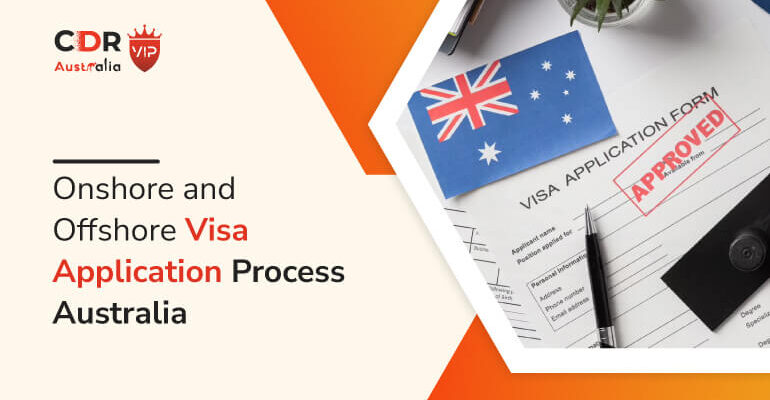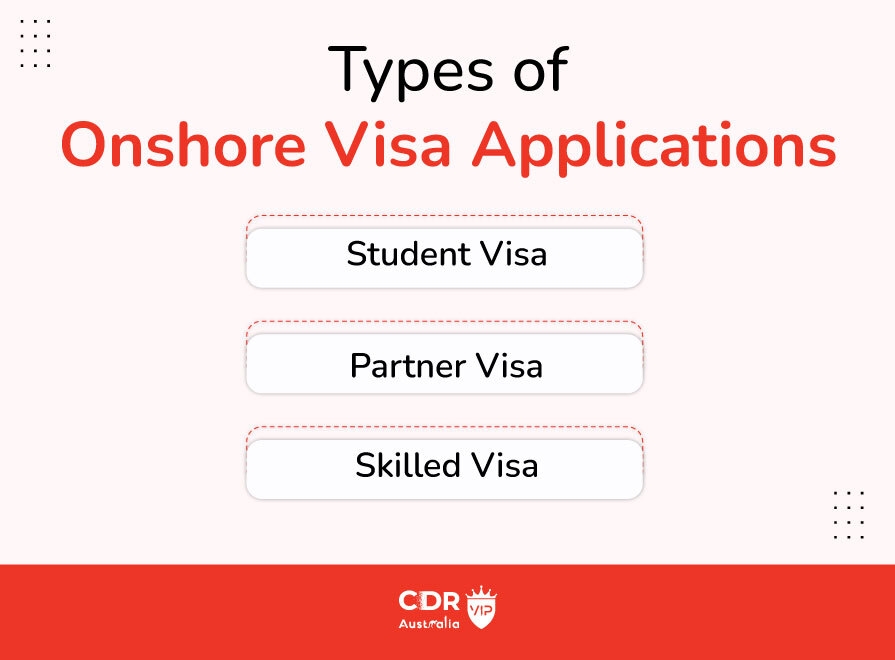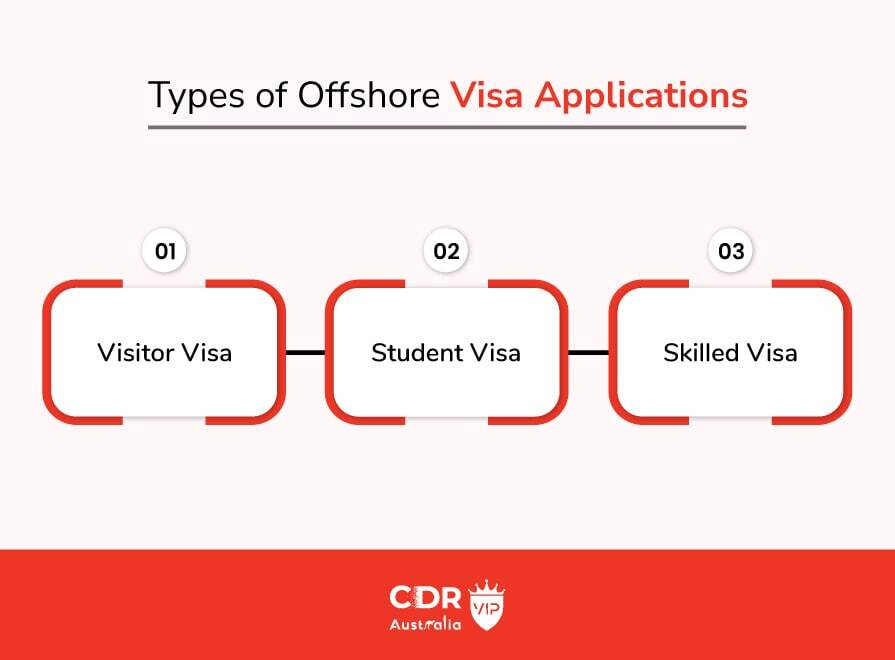Onshore and Offshore Visa Application Process

Onshore and Offshore Visa Application Process
Australia is a popular destination for tourists, students, and professionals alike. With its picturesque landscapes, thriving cities, and diverse culture, it draws millions of visitors each year. If you plan to visit Australia, you will need an onshore and offshore visa application to enter the country.
There are two types of visa application processes available: Onshore and Offshore visa application. This blog will discuss the differences between the two approaches and provide all the information you need to apply for an onshore and offshore visa application visa to Australia.
Onshore Visa Application
The onshore visa application process is for people who are already in Australia and wish to extend their stay, change their visa type or apply for a new visa. If you are currently in Australia on a visitor visa or any other temporary visa, you can apply for a new visa while you are still in the country.
Types of Onshore Visa Applications
There are different types of onshore visas available, including:

-
Student Visa
This visa is for international students who want to study in Australia. You can apply for a student visa while in the country if you are currently on a visitor visa.
-
Partner Visa
If you are in a genuine relationship with an Australian citizen, permanent resident, or eligible New Zealand citizen, you may be eligible to apply for a partner visa.
-
Skilled Visa
This visa is for skilled workers who desire to work and live in Australia. You can apply for a skilled visa with the necessary skills and qualifications.
Process for Onshore Visa
Onshore visa applications are for people already in Australia who wish to extend their stay or change their visa status. There are several types of onshore visas, including student visas, work visas, partner visas, and skilled visas.
Step 1: Determine the sort of visa you want to apply for
The first step in the onshore visa application process is determining which type of visa you wish to use. A complete list of permits is available on the Department of Home Affairs website.
Step 2: Check the eligibility criteria
Once you have determined which visa to apply for, you must check the eligibility criteria. Each access has its requirements; you must meet them all to be eligible.
Step 3: Submit an Expression of Interest (EOI)
You must present an Expression of Interest (EOI) through SkillSelect if you apply for a skilled visa. SkillSelect is an online service that allows skilled workers and business people to express their interest in migrating to Australia.
Step 4: Lodge the application
Once you have determined which visa you want to apply for and have checked the eligibility criteria, the next step is to lodge your application. You can install your application online or individually at a Department of Home Affairs office.
Step 5: Wait for the decision
After you have lodged your application, you must wait for the decision. The processing time for onshore visas can vary depending on the type of visa you have applied for.
Onshore Detection and Processing
The Department of Home Affairs has several methods for detecting onshore visa applicants, including:
-
Data Matching
The Department of Home Affairs matches data from various sources, including tax records, employment records, and social security records, to identify people who are in Australia on expired visas or without visas.
-
Compliance Monitoring
The Department of Home Affairs monitors compliance to ensure visa holders comply with their conditions. It includes tracking the work and study rights of visa holders.
-
Tip-offs
The Department of Home Affairs receives tip-offs from the public about suspected visa breaches, including employers and community members.
Read more: Top 5 facts about the Australian skilled migration assessment 💼💼
Stages of Onshore Visa Application
Once an onshore visa application has to get lodged, it goes through several processing stages. These stages can include:
1. Acknowledgment of Receipt
The Department of Home Affairs acknowledges receipt of the visa application and provides a Transaction Reference Number (TRN).
2. Initial Assessment
The Department of Home Affairs conducts an initial assessment of the visa application to determine if all the necessary information has to get provided.
3. Further Assessment
If additional information is required, the Department of Home Affairs may request it from the applicant.
4. Visa Grant or Refusal
Once the assessment is complete, the Department of Home Affairs will either grant or refuse the application.
Note:
The onshore visa application process is for people already in Australia and wishes to extend their stay or change their visa status. It is essential to determine which type of visa you want to apply for, check the eligibility criteria, and lodge your application correctly.
The Department of Home Affairs uses various methods to detect onshore visa applicants who breach their visa conditions. Once the visa application gets installed, it goes through several processing stages before deciding.
If you have any inquiries or concerns regarding visa application, you can always seek the advice of a migration agent or contact the Department of Home Affairs.
Offshore Visa Application
The offshore visa application process is for people who are outside of Australia and wish to apply for a visa to get inside the country. If you are out of Australia, you must apply for a visa through an Australian embassy, high commission, or consulate.
Types of Offshore Visa Applications
There are different types of offshore visas available, including:

-
Visitor Visa
This visa is for those who wish to visit Australia for tourism or business purposes.
-
Student Visa
This visa is for international students who wish to study in Australia.
-
Skilled Visa
This visa is for skilled workers who desire to work and live in Australia.
Read more: Top 10 reasons for CDR Rejection 💼💼
Process for Offshore Visa Application
The process for applying for an offshore visa is similar to that of an onshore visa. Here is the process you need to follow to apply for an offshore visa:
Step 1: Choose the type of visa you want to apply for
The first step is determining the visa type you wish to use. A complete list of permits is available on the Department of Home Affairs website.
Step 2: Check the eligibility criteria
Before applying for a visa, you must meet the eligibility criteria. Each visa has prerequisites; you must meet them all to be eligible.
Step 3: Gather the required documents
Once you have determined which visa you want to apply for and have checked the eligibility criteria, the next step is to gather all the required documents. The documents you must provide will vary depending on the sort of visa you are applying for.
Step 4: Lodge the application
You can lodge your application online or in person at an Australian embassy, high commission, or consulate. You must pay the visa application fee at the time of lodgement.
Step 5: Wait for the decision
After you have lodged your application, you must wait for the decision. The processing time for visas can differ depending on the type of visa you have applied for.
Critical Differences Between Onshore and Offshore Visa Application Processes
1. Location
The applicant’s location is the main difference between the two processes. The onshore visa application process is for people already in Australia, while the offshore visa application process is for people outside Australia.
2. Eligibility
The eligibility criteria for the onshore and offshore visa application can vary. For example, some visas are only available for onshore applicants, while others are only for offshore applicants.
3. Processing Time
The processing time for the onshore and offshore visa applications can vary. Generally, onshore visas have a shorter processing time than offshore visas.
4. Cost
The cost of applying for a visa can also vary depending on whether you use it onshore or offshore.
5. Supporting Documents
The documents required for the onshore and offshore visa application can also differ. For example, if you are applying for an onshore visa, you may need to provide evidence of your current visa status.
Read More: Step-by-step process to get an Australian PR in 2023 💪💪
Tips for a Successful Visa Application
Regardless of whether you are applying for an onshore or offshore visa application, there are several tips you can follow to increase your chances of a successful application.
-
Ensure you meet the eligibility criteria.
Before you apply for a visa, ensure you meet all the eligibility criteria. You must meet the requirements to ensure your application is accepted.
-
Provide all required documents.
Ensure you provide all the required documents when you lodge your application. Your application may get delayed or only be accepted if you provide all the necessary documents.
-
Be honest in your application.
Being frank in your visa application is essential. Your application will likely only be accepted if you provide accurate and accurate information.
-
Keep copies of all documents.
Ensure you keep copies of all the documents you provide with your application. These copies will make it easier to provide additional information if requested.
-
Follow up on your application.
If you have not received a decision on your onshore and offshore visa application within the processing time, you can follow up with the Department of Home Affairs or the relevant Australian embassy or consulate.
Read more: Top 10 most-demanded Engineering fields in Australia 💼💼
Why CDRAustraliaVIP?
Because of the following reasons:
1. Expertise
Visa application services such as CDRAustraliaVIP have experts in Australian immigration law and visa application processes. These experts can provide guidance and assistance to ensure your application is submitted correctly and meets all the requirements.
2. Time-saving
Applying for an onshore and offshore visa application can be a complex and time-consuming process. By using a visa application service, you can save time by having experts handle the paperwork and assist with the application process.
3. Increased Chance of Success
Onshore and offshore Visa application services have experience preparing successful applications. They can guide the necessary documents, evidence, and information that need to be included in your application to increase your chances of success.
4. Assistance with Complicated Cases
If your case is complicated or has unique circumstances, a visa application service can help and guide you to ensure your application meets all the requirements.
5. Support throughout the Process
Applying for a onshore and offshore visa application visa can be arduous, and having support and guidance can be helpful. Visa application services can provide ongoing support throughout the visa application process.
Conclusion
Applying for a onshore and offshore visa application visa to Australia can be a complex process. Still, following the steps outlined in this blog, you should be able to apply for an onshore and offshore visa application successfully. Remember to check the eligibility criteria for the visa you want to use, gather all the required documents, and be honest in your application.
If you have any queries or concerns, you can always seek the advice of a migration agent or contact the Department of Home Affairs. Good luck with your visa application!


